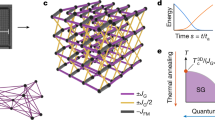Abstract
Most realistic solid state devices considered as qubits are not true two-state systems. If the energy separation of the upper energy levels from the lowest two levels is not large, then these upper states may affect the evolution of the ground state over time and therefore cannot be neglected. In this work, we study the effect of energy levels beyond the lowest two energy levels on adiabatic quantum optimization in a device with a double-well potential as the basic logical element. We show that the extra levels can be modeled by adding additional ancilla qubits coupled to the original logical qubits, and that the presence of upper levels has no effect on the final ground state. We also study the influence of upper energy levels on the minimum gap for a set of 8-qubit spin glass instances.
Similar content being viewed by others
References
Nielsen M., Chuang I.: Quantum Computation and Quantum Information. Cambridge University Press, Cambridge (2000)
Nakamura Y., Pashkin Yu.A., Tsai J.S.: Coherent control of macroscopic quantum states in a single-Cooper-pair box. Nature (London) 398, 786–788 (1999)
Yamamoto T., Pashkin Yu.A., Astafiev O., Nakamura Y., Tsai J.S.: Demonstration of conditional gate operation using superconducting charge qubits. Nature (London) 425, 941–944 (2003)
Vion D., Aassime A., Cottet A., Joyez P., Pothier H., Urbina C., Esteve D., Devoret M.H.: Manipulating the quantum state of an electrical circuit. Science 296, 886–889 (2002)
Steffen M., Ansmann M., Bialczak R.C., Katz N., Lucero E., McDermott R., Neeley M., Weig E.M., Cleland A.N., Martinis J.M.: Measurement of the entanglement of two superconducting qubits via state tomography. Science 313, 1423–1425 (2006)
Berkley A.J., Xu H., Ramos R.C., Gubrud M.A., Strauch F.W., Johnson P.R., Anderson J.R., Dragt A.J., Lobb C.J., Wellstood F.C.: Entangled macroscopic quantum states in two superconducting qubits. Science 300, 1548–1550 (2003)
Mooij J.E., Orlando T.P., Levitov L., Tian L., van der Wal C.H., Lloyd S.: Josephson persistent-current qubit. Science 285, 1036–1039 (1999)
Grajcar M., Izmalkov A., Ilíchev E., Wagner Th., Oukhanski N., Hübner U., May T., Zhilyaev I., Hoenig H.E., Greenberg Ya. S., Shnyrkov V.I., Born D., Krech W., Meyer H.-G., van den Brink A.M., Amin M. H.S.: Low-frequency measurement of the tunneling amplitude in a flux qubit. Phys. Rev. B 69, 060501(R)–060503(R) (2004)
Harris R., Johansson J., Berkley A.J., Johnson M.W., Lanting T., Han S., Bunyk P., Ladizinsky E., Oh T., Perminov I., Tolkacheva E., Uchaikin S., Chapple E., Enderud C., Rich C., Thom M., Wang J., Wilson B., Rose G.: Experimental demonstration of a robust and scalable flux qubit. Phys. Rev. B 81, 134510–134528 (2010)
Johnson M.W., Amin M. H. S., Gildert S., Lanting T., Hamze F., Dickson N., Harris R., Berkley A.J., Johansson J., Bunyk P., Chapple E.M., Enderud C., Karimi K., Ladizinsky E., Ladizinsky N., Oh T., Perminov I., Rich C., Thom M.C., Tolkachev E., Truncik C. J.S., Uchaikin S., Wang J., Wilson B., Rose G.: Quantum annealing with manufactured spins. Nature 473, 194–198 (2011)
Castellano M.G., Chiarello F., Carelli P., Cosmelli C., Mattioli F., Torrioli G.: Deep-well ultrafast manipulation of a SQUID flux qubit. New J. Phys. 12, 043047 (2010)
Farhi E., Goldstone J., Gutmann S., Lapan J., Lundgren A., Preda D.: A quantum adiabatic evolution algorithm applied to random instances of an NP-complete problem. Science 292, 472 (2001)
Santoro G.E., Martoák R., Tosatti E., Car R.: Theory of quantum annealing of an Ising spin glass. Science 295, 2427–2430 (2002)
Aharonov, D., van Dam, W., Kempe, J., Landau, Z., Lloyd, S., Regev, O.: Adiabatic quantum computation is equivalent to standard quantum computation. In: Proceedings of the 45th FOCS, pp. 42–51 (2004)
Mizel A., Lidar D.A., Mitchell M.: Simple proof of equivalence between adiabatic quantum computation and the circuit model. Phys. Rev. Lett. 99, 070502–070505 (2007)
Harris R., Johnson M.W., Lanting T., Berkley A.J., Johansson J., Bunyk P., Tolkacheva E., Ladizinsky E., Ladizinsky N., Oh T., Perminov I., Enderud C., Rich C., Uchaikin S., Thom M.C., Chapple E.M., Wang J., Wilson B., Amin M.H.S., Dickson N., Karimi K., Macready B., Truncik C.J.S., Rose G.: Experimental investigation of an eight qubit unit cell in a superconducting optimization processor. Phys. Rev. B 82, 024511–024525 (2010)
Brooke J., Bitko D., Rosenbaum T.F., Aeppli G.: Quantum annealing of a disordered magnet. Science 284, 779–781 (1999)
Brooke J., Rosenbaum T.F., Aeppli G.: Tunable quantum tunnelling of magnetic domain walls. Nature 413, 610–613 (2001)
Author information
Authors and Affiliations
Corresponding author
Rights and permissions
About this article
Cite this article
Amin, M.H.S., Dickson, N.G. & Smith, P. Adiabatic quantum optimization with qudits. Quantum Inf Process 12, 1819–1829 (2013). https://doi.org/10.1007/s11128-012-0480-x
Received:
Accepted:
Published:
Issue Date:
DOI: https://doi.org/10.1007/s11128-012-0480-x




